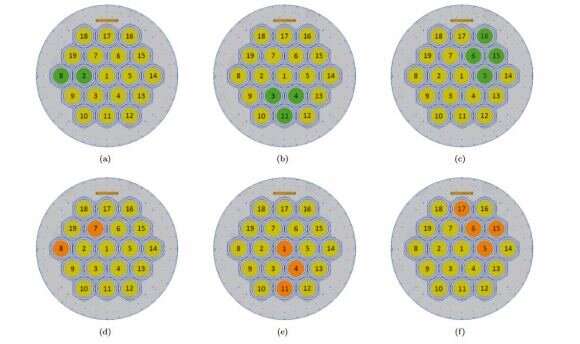The Five-hundred-meter Aperture Spherical Telescope (FAST), located in China, is currently the world’s largest and most sophisticated radio observatory.

While its primary purpose is to conduct large-scale neutral hydrogen surveys (the most common element in the universe), study pulsars, and detect Fast Radio Bursts (FRBs), scientists have planned to use the array in the Search for Extraterrestrial Intelligence (SETI). Integral to this field of study is the search for technosignatures, signs of technological activity that indicate the presence of an advanced civilization.
While many potential technosignatures have been proposed since the first surveys began in the 1960s, radio transmissions are still considered the most likely and remain the most studied. In a recent survey, an international team of SETI researchers conducted a targeted search of 33 exoplanet systems using a new method they call the “MBCM blind search mode.” While the team detected two “special signals” using this mode, they dismissed the idea that they were transmissions from an advanced species. Nevertheless, their survey demonstrated the effectiveness of this new blind mode and could lead to plausible candidate signals in the future.
The survey was conducted by researchers representing the FAST collaboration, Breakthrough Listen, and multiple universities and institutes. This included the Institute for Frontiers in Astronomy and Astrophysics at Beijing Normal University, the Beijing Academy of Science and Technology, the Space Sciences Laboratory (SSL) at UC Berkeley, the Institute for Astronomical Science at Dezhou University, the College of Physics and Electronic Engineering at Qilu Normal University, and the University of Glasgow. The paper that describes their work has been accepted for publication by the Astrophysical Journal.
The first SETI experiment (Project Ozma) took place in 1960 under the direction of Professor Frank Drake, for whom the Drake Equation is named. Since then, most SETI experiments have searched for radio communications as technosignatures due to their effectiveness at propagating through interstellar space. The earliest experiments searched at specific frequencies, like the absorption line of neutral hydrogen (21 cm) and hydroxyl (18 cm), which correspond to radio frequencies of 1.4 and 1.6 gigahertz (GHz).
But with the advancement of technology, the available bandwidth of SETI systems has expanded into the tens of GHz range. In addition, SETI surveys have come to rely on a strategy known as Multibeam Coincidence Matching (MBCM) to address RFI and filter it out of their signal noise. Dr. Vishal Gajjar—a researcher at the SETI Institute, UC Berkeley, and a co-author on the study—explained to Universe Today via email:
“Single-dish radio telescopes observe a small portion of the sky, known as a beam, which is about the size of the tip of a pencil held at arm’s length. Despite their accuracy, these telescopes often pick up interference from nearby terrestrial sources. To overcome this issue, some telescopes are equipped with multiple beams, allowing them to observe several small areas of the sky at the same time. By searching for signals of interest in all beams simultaneously, we can determine if a signal is truly from a source in the sky or if it is a result of interference. When a signal is detected in multiple beams, it is likely to be terrestrial interference.”
According to Gajjar, MCBM is considered better than conventional methods for three main reasons. These include:
- Increased accuracy and robustness: MBCM can eliminate false positive detections caused by terrestrial interference, resulting in more accurate results. MBCM is less susceptible to interference from terrestrial sources, making it more robust and reliable than conventional methods.
- Faster processing: MBCM can be performed in real-time, making it faster than traditional methods that require post-processing.
- Increased coverage: MBCM allows for a wider field of view by using multiple beams, providing more coverage than a single beam.

Artist impression of a fast radio burst (FRB). Credit: Danielle Futselaar
This third advantage was integral to the work of Dr. Gajjar and the international team. The FAST telescope is the world’s largest radio array and is equipped with a 19-beam receiver, allowing astronomers to simultaneously observe 19 different positions in the sky. When paired with FAST’s instruments, the MCMB technique effectively eliminates sources of interference and ensures accurate observations. For their study, the team observed 33 nearby exoplanets using the traditional MBCM strategy and a new search method they call the “MBCM blind search mode.”
As they indicate in their paper, the blind search mode was inspired by the multibeam blind search mode that was recently developed to study FRBs. The basic idea is to use all 19 of FAST’s beams to search for ETI signals, where the central beam (Beam 1) tracks a target while the others serve as reference beams. If a signal covers non-adjacent beams, more than four adjacent beams, or three or more beams in a line, the team classified the signal as RFI. They also identify four beam coverage arrangements that could indicate radio signals that are ETI in origin.
As illustrated in the diagram below, these included any one of FAST’s 19 beams, two of the adjacent beams (Figure 1a), three adjacent beams forming an equilateral triangle (Figure 1b), and four adjacent beams forming a compact rhombus (Figure 1c). Any beam coverage arrangements that did not fit into these four categories (like the three examples in the second line of the diagram) were considered false positives and rejected. As Gajjar indicated, this paper builds on previous work where they conducted targeted observations with FAST of the same 33 exoplanetary systems:
“During those observations, we aimed the central beam of our 19-beam receiver at each individual target and only analyzed data from the central beam where the target was situated. If a signal of interest was detected, we cross-checked the same frequency across other beams to eliminate terrestrial interference. In the present paper, we perform a more comprehensive search by blindly searching for signals across all 19 beams, regardless of the presence of any exoplanetary system in the field of view. This approach allows us to conduct an agnostic search without prior knowledge of any potential targets of interest present in our beams.”

Schematics of the MBCM blind search mode. The first row shows three examples of allowed signals, and the bottom row shows three examples of forbidden signals. Credit: Luan, Xiao-Hang, et al. (2023)
After scanning these 33 exoplanets, the team discerned two rather unusual and intriguing signals. As Gajjar related, while it was challenging to evaluate these signals (as they only appeared in one beam), after a thorough examination, they determined that they were just RFI interference:
“One of the signals was only present in one of the two polarizations of the telescope. Normally, sky-based sources would show similar intensity in both polarizations over a longer period of observation, but this wasn’t the case for the first signal, making it easy to dismiss. The second signal was more intriguing as it showed the same intensity in both polarizations. Upon closer inspection, we discovered that the frequency of the second signal was very close to known sources of interference.”
In another case, further examination of the data revealed a signal in one beam with a very low signal-to-noise (STN) ratio. The team also rejected this signal because its behavior was similar to other instances of RFI they had identified. While no clear technosignatures were detected, the survey was invaluable because of the way it tested the team’s silent mode technique. What’s more, the two signals identified are fitting targets for follow-up observations, which could be conducted by Breakthrough Listen (the largest SETI effort ever mounted) in the coming years.
“This is a groundbreaking stride in the field of SETI,” said Gajjar. “In SETI, this technique has been deployed for the first time. This unique technique can be useful because it reduces the amount of false positives, allowing for a more efficient search for signals from extraterrestrial civilizations. By reducing the amount of interference, multibeam coincidence rejection increases the sensitivity of the search and makes it easier to detect weak signals that might otherwise be overlooked.”
Source: Thaiupdates.info








